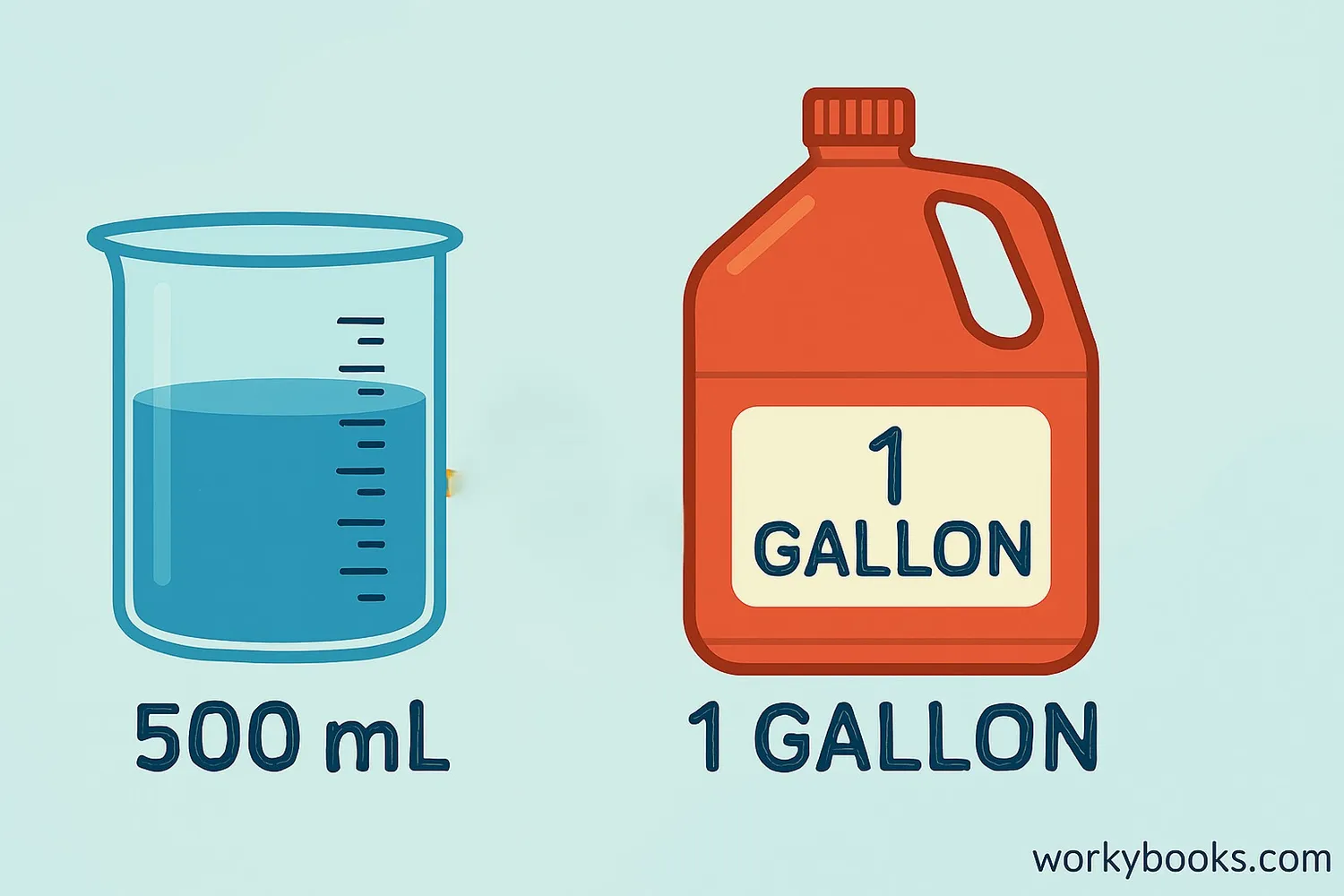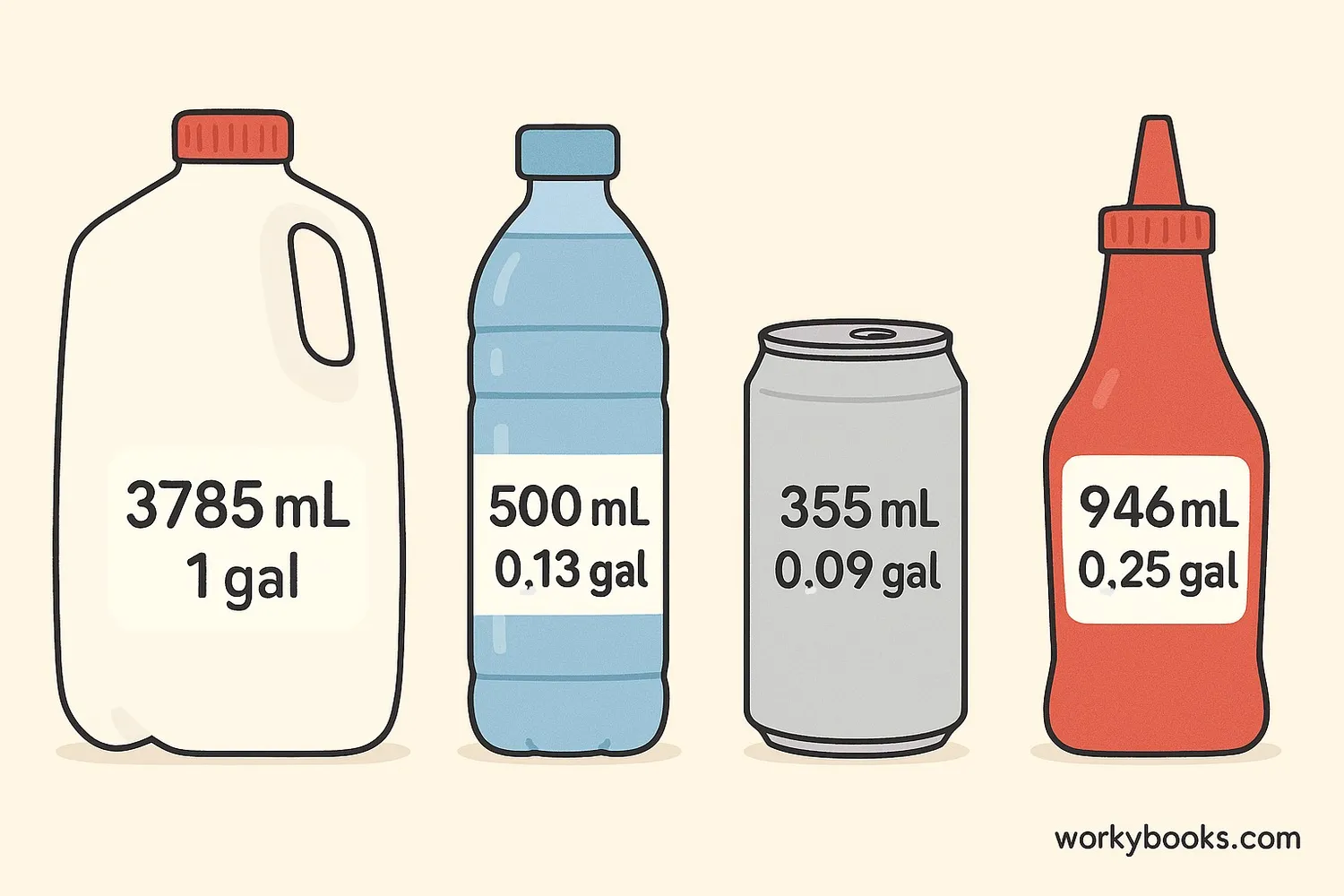Milliliters to Gallons (mL to gal) - Definition, Examples, Quiz, FAQ, Trivia
Learn to convert between metric and US customary liquid volume measurements with easy explanations and practice activities
What is Liquid Volume Conversion?

Liquid volume conversion means changing a measurement from one unit to another. In this lesson, we're learning how to convert between milliliters (used in the metric system) and gallons (used in the US customary system).
Why do we need to convert? Different countries use different measurement systems. Most countries use milliliters and liters, while the United States primarily uses gallons, quarts, and cups. Scientists also use metric measurements for consistency.
One gallon equals 3,785 milliliters. To convert milliliters to gallons, we divide the number of milliliters by 3,785. Understanding this relationship helps us compare measurements and solve real-world problems.
Key Concept
1 gallon = 3,785 milliliters. This relationship is the foundation for all mL-to-gallon conversions.
How to Convert Milliliters to Gallons
Converting milliliters to gallons is simple once you remember the conversion factor:
Conversion Formula
To convert any measurement in milliliters to gallons, divide the number of milliliters by 3,785.
Example: Convert 7,570 milliliters to gallons
Step 1: Start with the measurement in milliliters → 7,570 mL
Step 2: Divide by 3,785 → 7,570 ÷ 3,785
Step 3: Calculate the result → 2 gallons
So 7,570 milliliters equals 2 gallons. Easy, right?
Remember
When converting milliliters to gallons, your answer will be a much smaller number because gallons are larger units than milliliters.
Milliliters to Gallons Conversion Charts
Conversion charts help us quickly find equivalent measurements without calculating each time. Here are two useful charts for converting milliliters to gallons:
Milliliters to Gallons Conversion Chart
| Milliliters (mL) | Gallons (gal) |
|---|---|
| 100 mL | 0.026 gal |
| 500 mL | 0.132 gal |
| 1,000 mL | 0.264 gal |
| 1,500 mL | 0.396 gal |
| 2,000 mL | 0.528 gal |
| 2,500 mL | 0.660 gal |
| 3,000 mL | 0.793 gal |
| 3,785 mL | 1.000 gal |
| 5,000 mL | 1.321 gal |
| 7,570 mL | 2.000 gal |
Common Container Sizes Conversion Chart
| Container | Milliliters (mL) | Gallons (gal) |
|---|---|---|
| Standard water bottle | 500 mL | 0.132 gal |
| Soda bottle | 2,000 mL | 0.528 gal |
| Large juice bottle | 3,000 mL | 0.793 gal |
| Milk jug | 3,785 mL | 1.000 gal |
| Large water dispenser | 18,925 mL | 5.000 gal |
Chart Tip
Notice how 3,785 milliliters equals exactly 1 gallon? You can use this as a reference point for estimation!
Real-World Examples

Let's practice conversion with some real-world examples:
Example 1: A standard water bottle contains 500 milliliters. How many gallons is this?
Solution: 500 ÷ 3,785 ≈ 0.132 gallons
Example 2: A large juice bottle contains 3,000 milliliters. What is this volume in gallons?
Solution: 3,000 ÷ 3,785 ≈ 0.793 gallons
Example 3: A car's gas tank holds 56,775 milliliters of gasoline. Convert this to gallons.
Solution: 56,775 ÷ 3,785 = 15 gallons
Example 4: A recipe calls for 1.5 gallons of water. How many milliliters is this?
Solution: To convert gallons to milliliters, multiply by 3,785: 1.5 × 3,785 = 5,677.5 mL
Practice converting measurements you see around you - your water bottle, milk jug, or the gasoline at the pump!
Conversion Tip
To convert gallons back to milliliters, multiply by 3,785 instead of dividing.
Conversion Practice Quiz
Test your conversion skills with this 5-question quiz. Choose the correct answer for each question.
Frequently Asked Questions
Here are answers to common questions about milliliters and gallons conversion:
Measurement Trivia
Discover interesting facts about liquid measurement systems:
Origin of the Milliliter
The milliliter was introduced during the French Revolution as part of the metric system. It was defined as one thousandth of a liter, which was originally based on the volume of 1 kilogram of water.
Global Standard
Over 95% of the world's population uses the metric system with milliliters in daily life. Only three countries (United States, Liberia, and Myanmar) have not officially adopted the metric system as their primary system.
Medicine Measurements
Even in the United States, milliliters are used for medicine measurements. This helps prevent dosage errors since metric measurements are more precise and consistent than teaspoons or tablespoons.
Largest Container
The world's largest container ship can carry over 24,000 twenty-foot equivalent units (TEUs). If converted to milliliters, this would be approximately 480,000,000,000 mL (480 billion milliliters)!


